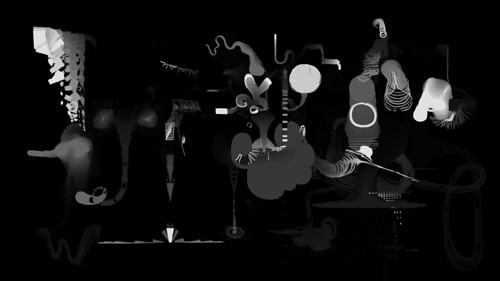From Bell Labs to Best Buy: Takeshi Murata and Jacob Ciocci in Conversation with PREDRIVE: After Technology Curator Melissa Ragona

Takeshi Murata, Homestead Grays, 2008, Video and hand-drawn animation.
PREDRIVE: After Technology (currently on exhibition at The Mattress Factory, Pittsburgh, PA, November 14 - April 5, 2009) features new works by six international artists including Takeshi Murata, Paper Rad, Gretchen Skogerson, Antoine Catala, and Brody Condon. The exhibition was conceived with a very specific group of artists in mind -- artists who placed both the dysfunction and arrogance of ever-changing technologies at the center of their work. In a sense, these artists are working in the shadow of a technological dystopia (and euphoria) that had begun as early as the Industrial Revolution -- as expressed in the vacant, vectored glances mapped out in Edouard Manet's The Balcony (1868-69) or the absolute pleasure of stop-motion animation in Georges Melies' An Up-To-Date Conjuror (1899).
Below, I speak with two of the featured artists in the show, Takeshi Murata and Jacob Ciocci (of Paper Rad) -- we cover everything from readymade software aesthetics to the dream of the perfect collector -- someone willing to take the risk of simply buying an idea. -- Melissa Ragona
Melissa Ragona: Last night I was asking about how you each manipulate your work at the level of the pixel. But, in a larger sense, I want to know where your work is going in terms of its relationship to technology -- especially because "PREDRIVE" is about what I am calling, the anti-wow effect of new technologies -- the disappointment of new technologies' promise to bring us somewhere else faster or to offer a yet-to-be imagined visual/audio space. I first became interested in so-called "new media," through structuralist film, focusing on filmmakers like Hollis Frampton, Paul Sharits, Tony Conrad, Joyce Wieland, Michael Snow, Peter Kubelka, et al. And then began exploring, a second generation of filmmakers who were also interested in film as epistemology (studied at the levels of the frame, or projection systems, or editing) primarily through the Six Pack group in Vienna which included filmmakers like Martin Arnold, Brigitta Burger-Utzer, Alexander Horwath, Lisl Ponger and Peter Tscherkassky. And, then most recently, artists involved in information visualization projects like Martin Wattenberg, Lisa Jevbratt, Ben Fry or Golan Levin. So, while I am still interested in work that is rigorously formal and reflexive about the use of technology - I am less impressed by what it produces visually. So, I know that in your [addressing Takeshi] most recent work you seem to be experimenting with freer, more improvisational forms. Or it seems that the focus is more on the relationship between frames rather than at the level of the pixel [as in Monster Movie or Escape Spirit VideoSlime].
Takeshi Murata: Yeah, but for me it has more to do with working within a different historical context. In the work I was doing earlier [as in Monster Movie] -- it's a great open territory -- working with new tools like computers or software programs. The technology is moving so quickly that there's much less of a framework through which to see the work. Now that I am working with more traditional forms of animation again, I have its history to work from, for better or worse.
Jacob Ciocci: So I have a question for Takeshi -- so what's an example of this newer form you were referring to, you mean like rethinking animation? And which older pieces of yours are we talking about?
TM: Well, like Monster Movie. And I'm thinking mostly about the level of incorporation of the computer, or where it’s incorporated. I initially was drawn to using the computer because of the speed. When I started to work with hand-drawn animation again, one of the main issues that was really important to me was the length of time it took to make work. If you can make something really quickly, it can change everything. I learned by doing traditional animation -- you know, you would write out script, storyboard, keyframing, you know all the classic stuff. But, in the end, like 90% of it is simply pounding it out.
READ THE COMPLETE INTERVIEW AT RHIZOME.ORG
-----
Posted by JEFFREY
-----

No comments:
Post a Comment